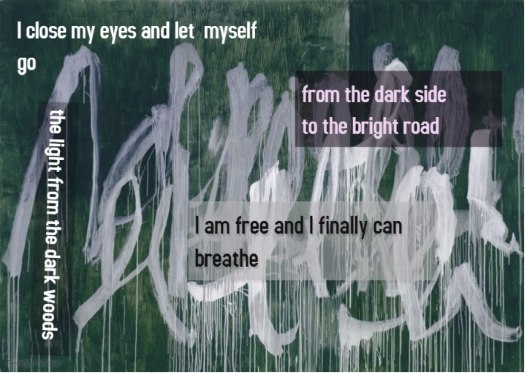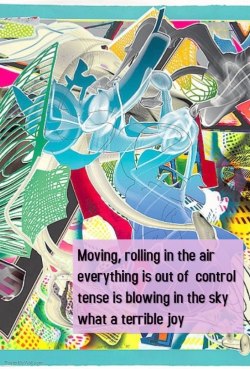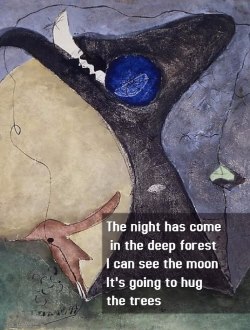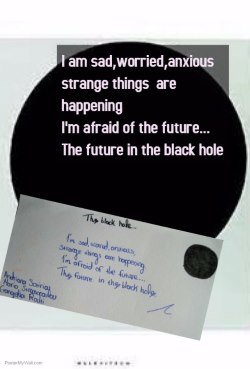- Contents
- Short Articles
- Using Art as a Compelling Means to Creative Writing: Insights into a Classroom Research Project
Using Art as a Compelling Means to Creative Writing: Insights into a Classroom Research Project
Maria Barberi holds an MA in Comparative Literature from U.E.A, U.K, and works as an EFL teacher at the state secondary school of Mandra, Greece. Her proposal on motivating students into creative writing through Art and Literature was awarded the International House John Haycraft Classroom Exploration scholarship for IATEFL 2016. She is interested in Literature, the Arts including music, creative writing, storytelling, global and social issues while she is currently actively involved in European school projects. Email:mabarberi@gmail.com
Introduction
It is generally agreed that creativity as a key competence should be developed at school. According to a European wide survey, 95% of teachers acknowledge the need of placing emphasis on fostering skills that inform creativity across all subjects ( European Commission, 2009 ). If such a pedagogical attitude is adopted, a creative writing methodology should be an essential component of the curriculum. Creative writing is important because the activities involved in it are associated with the so called ‘higher order thinking skills’. When students engage in creative writing they combine imagination with intellectual inventiveness; two of the basic constituents of creativity according to Webster’s New World Dictionary Essential Vocabulary (Webster’s New World Dictionary Essential Vocabulary, 2005). They are invited to select, combine and justify through reasoning the elements they choose in order, for example, to write a short story or a poem; and this way they also develop their critical thinking. Recognizing the valuable educational dimensions of a creative writing research project, I decided to apply it in the context of a Greek secondary state school, in a class of 25 third graders, aged 15 (CEFR B1-B2). The project is based on an aspect of creative writing methodology I have always wanted to explore, viz. using visual stimuli (paintings) to motivate teenage students to engage in creative writing. Last, but not least, I hoped to gain a greater awareness of the behaviour a teacher should adopt in order to promote creativity among teenage students and experience of what can nurture a creative mindset.
The rational of the research project
Throughout the project students were presented with carefully selected material accompanied by certain activities. Most activities were based on a series of questions which activated certain mental processes such as visual, critical and creative thinking. The final aim was to urge students to produce novel responses to open ended creative writing tasks. Students’ motivation would be measured by the quality of the particular responses, which should show signs of sensitivity, ingenuity, new insights and authentic creative self-expression. Positive emotions, enthusiasm, the quality of individual and team work, persistence and concentration throughout the given tasks would also be factors determining motivation. In addition, the evaluation results of the project would be based on students’ own feedback collected through comprehensive questionnaires and focus group interviews.
The narrative behind the landscape of images
“A well-chosen work of art is a self-contained world. It has all the information one needs to begin to interpret it. And its presence is a challenge to make new meaning.” (Housen, 2002, p.121). In other words, a painting is nothing else but a narrative open to many interpretations. We, as viewers, can reconstruct and give new meanings to it. In the light of this idea, students were presented with Cezanne’s painting “The Hanged Man’s house”. They were called to ‘step inside’, choose a point to stand, observe, make associations and explore their feelings about the place. Using all their senses, they made assumptions as to what might be going on.
Sample questions:
- What do you see from where you stand?
- What is there close to you and what can you see in the distance?
- What does this painting make you wonder?
- What time of the year/ day is it?
- Do you hear any sounds or is it just silence?
- Is the place populated or not?
- What are your feelings about the place?
- What is going on there?
After each question, they were given enough time to visualize and think. Their observations, feelings, assumptions were written up on the board. During the production stage, they were asked to write the opening lines of a chapter in a supposed novel of theirs.
Students’ sample work:
“The house was so mysterious, it was built between high trees that no one had planted. In the dusk, the mountains looked like dark giants that everyone was afraid of. The wind was blowing so hard that the leaves of the trees were falling down, and as a consequence, the trees were stark-naked. This place really scares me…” (Athena,15)
To work further on the plot of a story, students were presented with Cassatt’s painting "The Tea". After closely observing it, they were invited to answer a series of questions exploring the relationship between the two characters portrayed in the painting, their thoughts and feelings. They were also called to even imagine the sound of the characters’ voices and the words they used while addressing each other. A brief drama improvisation on the two women's movements as they get up and prepare tea followed. Students also had to think about what could happen 5 minutes after that scene and roughly devise the plot of a story.
After looking at various paintings, and working on the setting, characters, and plot of a short story in a similar way, students, were offered a collection of paintings to select from and write a short story in groups. The paintings that were used were both realistic and unrealistic or surrealistic in nature. In our case, paintings by Magritte R., Dali, S., Rousseau H., Chagall, M., proved to be powerful stimuli and were among students’ top choices.
Extract from the short story entitled: “The Shipwrecked”, based on Magritte’s painting, “The Sirens” (group work)
Day 30
“….It’s been a month since the ship sank. I wonder where the rest of the crew is. They might be dead. I’m on the west side of the Island. There is a statue here just like the one on the east side. These statues work like a compass. I think I can draw my own map and find my way back to Spain…”
Abstract art as stimulus to poetry
Step 1: Students were given 10 minutes to purposely “scribble” on large sheets of paper and connect their “scribblings” with a feeling, thought or memory. Then, they were encouraged to think about different ways of moving (roll, jump) and connect them with specific emotions (joy, anger). Afterwards, they described and justified their scribblings. Words expressing feelings, and words describing accompanying movements were written on the board.
Step 2: Posters of abstract paintings were put up on the walls of the classroom. Students got into groups. Each group had to “adopt” a painting, stand before it, and observe it for some time. Then, the individual members of each group had to write a short poem about the painting. Finally, the group had to get together to choose the best line from each individual poem and write a final group poem.
Publishing students’ work
The ‘new writers’ uploaded their work on a wiki built for the purposes of this project. Students from the other classes were directed to read it and offer motivational feedback. A ‘vote for the best poem’ poll was also conducted and this proved very successful among the wiki members.
Evaluation
Students remained positively motivated showing high degrees of concentration and persistence throughout the project. Collaborative work encouraged self–confidence and safety and allowed them, in most cases, to overcome difficulties concerning vocabulary and syntax while they were willing to discuss their final version with the teacher. On the whole, the creative writing products presented signs of sensitivity and ingenuity. Students’ positive motivation was also revealed in their written evaluation comments where the majority (65%) stated that they would write a short story or a poem either in Greek or in English in their free time as a result of this project.
Conclusion
Developing language skills, enhancing aesthetic judgement and sensitivity to each other’s work, were some of the impacts these activities had on students. What lies at the core of the project though, is creative experimentation and the tolerance that both the teacher and the learners had to develop towards innovative work in the classroom. By adopting a non-judgmental attitude, the teacher allowed the students’ texts to become “the location of an ongoing dialogue” (Dunlop, 2007, p.1257). This dialogue was informed by motivational and constructive comments, suggestions, thought–provoking questions that helped students unfold and refine their writing, acquire confidence, and become aware of their creative potential. The whole process added to the development of an autonomous attitude towards the object of learning. This fact is vividly expressed in an evaluation comment written by one of the students: “Next time we can actually draw our own painting and write our own poem”.
The dimension of research yielded benefits on personal level for it encouraged critical self-reflection and helped me gain further insight into my teaching, qualities which conform to the aims of classroom research practice. (Dikilitaᶊ, Smith, and Trotman, 2015, p.3) Last, but not least, through listening and observing attentively my students’ own needs, voices, and reactions I was offered the opportunity to cast a deeper look on elements that cannot be immediately or outwardly perceived when following traditional teaching methods. These elements had to do with the delicate, inward, elusive feelings which can spark inspiration and motivation and which are the source of creativity.
References
Dikilitaᶊ, K., Smith, R., Trotman, W., (Eds.). (2015). Teacher Researchers in Action, IATEFL
Dunlop, R., (2007). Human Music, A Case for Teaching Poetry in Dark Times. In L. Bresler (ed.). International Handbook of Research in Arts Education 16. Dordrecht: Springer
European Commission, (2009). Creativity in Schools in Europe: A survey of Teachers.
Retrieved from http://ftp.jrc.es/EURdoc/JRC55645_Creativity%20Survey%20Brochure.pdf
Herzog, D.A., (2005). Webster’s New World Essential Vocabulary, Wiley & Sons Retrieved from http://blog.sciencenet.cn/upload/blog/file/2009/4/200942712715213816.pdf
Housen, A., (2001-2002). Aesthetic Thought, Critical Thinking and Transfer: Visual Understanding in Education, Arts and Learning Research Journal, 18 (1), 99-131. Retrieved from http://citeseerx.ist.psu.edu/viewdoc/download?doi=10.1.1.467.3752&rep=rep1&type=pdf
Masturzo, H., (2002). Gestural Abstraction and the Art of Cy Twombly. In: Foster, T. and Prevallet, K., (eds.) Third Mind: Creative Writing through Visual Art, New York: Teachers and Writers Collaborative
Walsh-Piper, K. (2002). Image to Word: Art and Creative writing, Lanham: The Scarecrow Press
Appendix: Abstract art and poetry

Sample work based on Cy Twombly’s painting Note II (2005-2007)

Sample work based on the painting Catahar (1998) by F. Stella

Sample work based on the painting Cyclops (1947) by Th.Stamos

Sample work based on the painting Black Circle (1923) by K. Malevich
Please check the Creative Methodology for the Classroom course at Pilgrims website.
Bonnie Tsai Scholarship
Natalia Mukhina, RussiaOut of Fashion, Out of Mind? A Defence of MI Theory
Alex Moore, PolandPilgrims at IATEFL Conference, Brighton 2018
Abroad in a Village: What’s Next?
Bohdan Feshchak, UkraineCreating TKT Training Videos with Screen Recording: An Action Research
Tien Mai, VietnamListening Comprehension
Robin Usher, Saudi ArabiaUsing Art as a Compelling Means to Creative Writing: Insights into a Classroom Research Project
Maria Barberi, Greece